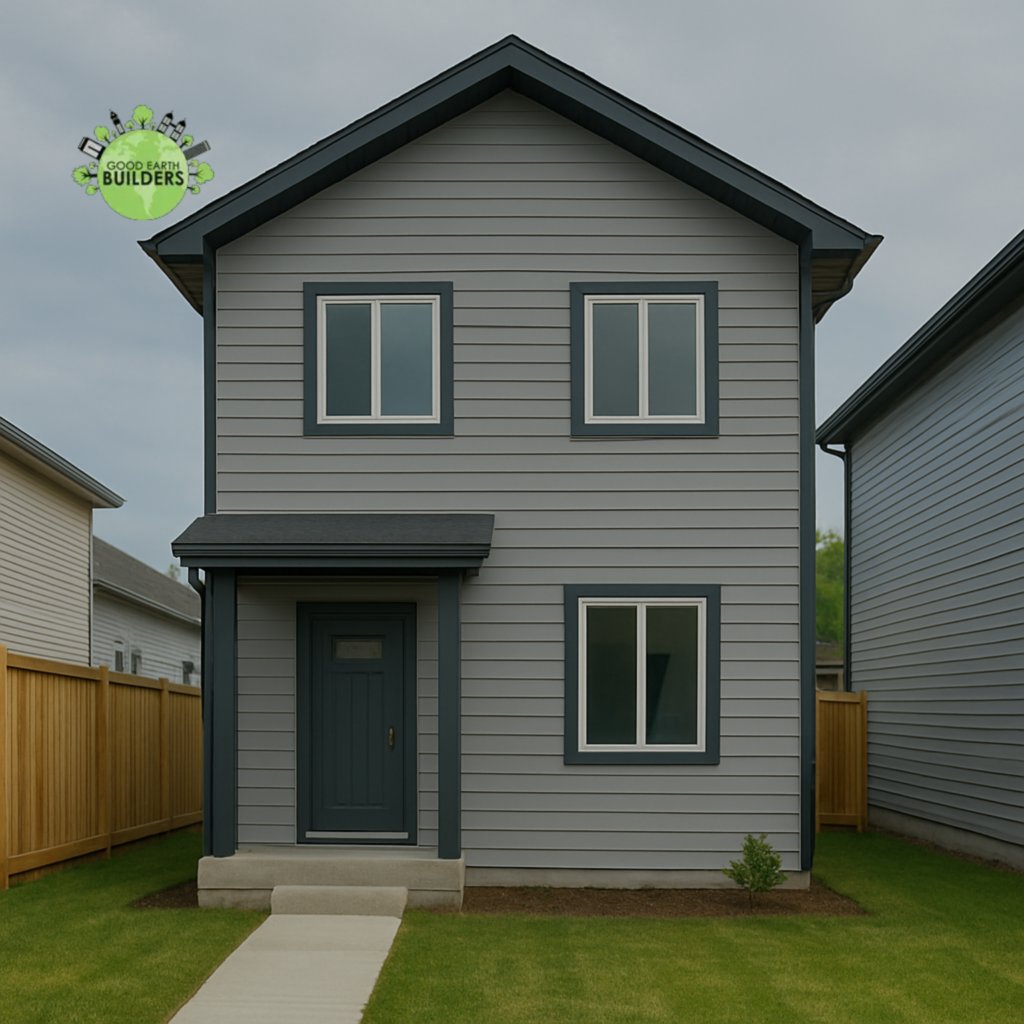Friday, August 8, 2025
Introduction: Calgary’s Laneway Home Revolution
In the face of rising housing costs and shrinking urban land availability, laneway homes have emerged as one of Calgary’s most innovative housing solutions. These compact, self-contained dwellings built in the backyard of existing properties represent a smart middle ground between single-family homes and high-density apartments.
The laneway home movement in Calgary has gained remarkable momentum since the city first legalized them in 2018. Recent data from the City of Calgary’s Planning Department shows:
- 1,287 laneway homes completed as of Q2 2025
- 83% increase in permit applications since 2022
- 92% occupancy rate for legal laneway suites
- Average construction timeline of 10-14 months
For homeowners, these secondary dwellings offer three compelling benefits:
- Rental Income Generation: With average rents between $1,400-$2,800/month, they provide substantial cash flow
- Multi-Generational Living: Ideal for aging parents or adult children needing independence
- Property Value Appreciation: Homes with legal suites sell for 12-18% more (Calgary Real Estate Board 2024)
This 3,500+ word guide will provide the most comprehensive look at laneway home construction in Calgary available today, covering all aspects from initial feasibility to long-term financial returns.
Understanding Calgary’s Laneway Home Regulations (2025 Edition)
Zoning & Land Requirements
Calgary’s laneway home bylaws have evolved significantly since their introduction. The 2025 regulations allow these dwellings in most residential zones (R-C1, R-C1L, R-C1N, R-C2) with these key parameters:
Lot Specifications:
- Minimum width: 7.5m (25 ft) for standard lots
- Special provisions for 6m (20 ft) wide lots in select communities
- Minimum depth: 30m (98 ft)
- Maximum coverage: 45% of rear yard area
Structure Requirements:
- Maximum size: 90m² (968 sq.ft.)
- Height limit: 6m (20 ft) with 8m (26 ft) pitched roof allowance
- Must maintain 3m (10 ft) separation from main house
- Minimum 1.2m (4 ft) setbacks from side/rear property lines
Parking & Access:
- 1 additional parking space required (can be tandem)
- Reduced to 0.5 spaces within 600m of LRT stations
- Minimum 3m (10 ft) wide access lane
- No overhead obstructions in alleyway
Pro Tip: The City’s Laneway Housing Tool provides parcel-specific feasibility checks.
2025 Bylaw Updates
Several important changes took effect January 2025:
- Heritage Area Adaptations
- Modified design standards for Mount Pleasant and Inglewood
- Allowance for sympathetic contemporary designs
- Energy Efficiency Requirements
- Minimum R-22 wall insulation (up from R-20)
- Air tightness testing mandatory
- Solar readiness provisions
- Approval Process Improvements
- Fast-track review for pre-approved designs
- Digital submission portal reducing review times by 30%
- Dedicated laneway home liaison at the City
The Complete Approval Process: A Realistic Timeline
Navigating Calgary’s development approval system requires patience and preparation. Here’s what to expect:
1. Pre-Application Phase (6-10 weeks)
- Site Survey & Assessment ($2,500-$5,000)
- Topographical survey
- Soil testing (especially for expansive clay areas)
- Utility capacity verification
- Preliminary Design ($5,000-$15,000)
- Conceptual drawings
- Shadow studies (for taller structures)
- Neighborhood character analysis
- Community Engagement (Recommended)
- Informal discussions with adjacent neighbors
- Early community association consultation
2. Development Permit (14-22 weeks)
- Submission Requirements:
- Site plan showing all dimensions and setbacks
- Architectural drawings (floor plans, elevations)
- Landscape plan including drainage
- Parking and circulation plan
- Photometric study (for lighting)
- Review Process:
- Initial screening (2 weeks)
- Circulation to internal departments (6 weeks)
- Public notification period (21 days minimum)
- Decision rendering (4 weeks)
Current Approval Rate: 78% on first submission
3. Building Permit (10-18 weeks)
- Required Documents:
- Structural engineering drawings
- Mechanical/electrical plans
- Energy efficiency calculations
- Construction details
- Key Considerations:
- New 2025 requirement: Whole-building air tightness testing
- Fire separation details between units
- Sound transmission ratings
4. Construction Phase (6-12 months)
Typical Sequence:
- Site preparation (2-4 weeks)
- Foundation (3-6 weeks)
- Framing (4-8 weeks)
- Enclosure (4-6 weeks)
- Interior finishes (6-10 weeks)
- Final inspections (2-4 weeks)
*Total Project Timeline: 12-24 months from conception to completion*
2025 Construction Cost Breakdown
Building costs have stabilized from pandemic peaks but remain elevated due to material and labor factors. Here’s the most detailed cost analysis available:
Site Preparation ($15,000-$40,000)
- Demolition of existing structures (if needed)
- Grading and compaction
- Temporary fencing and site security
- Soil remediation (if required)
Foundation ($20,000-$60,000)
| Type | Cost | Best For |
|---|---|---|
| Standard Concrete | $25-$35/sq.ft. | Most applications |
| Frost-Protected | $30-$45/sq.ft. | Poor soil conditions |
| Pile Foundation | $40-$60/sq.ft. | High water tables |
| Prefab Panels | $20-$30/sq.ft. | Fast-track projects |
Superstructure ($90,000-$180,000)
- Wood frame construction: $130-$160/sq.ft.
- Steel frame construction: $150-$190/sq.ft.
- Structural insulated panels (SIPs): $160-$210/sq.ft.
Exterior Enclosure ($40,000-$85,000)
- Roofing: $8-$15/sq.ft.
- Wall cladding: $12-$25/sq.ft.
- Windows/doors: $8,000-$20,000
- Insulation: $4,000-$10,000
Mechanical Systems ($35,000-$75,000)
- HVAC: $12,000-$25,000
- Plumbing: $10,000-$20,000
- Electrical: $8,000-$15,000
- Fire protection: $5,000-$15,000
Interior Finishes ($50,000-$120,000)
| Finish Level | Cost/Sq.Ft. | Features |
|---|---|---|
| Basic | $50-$80 | Laminate counters, vinyl flooring |
| Mid-Grade | $80-$120 | Quartz counters, engineered hardwood |
| Luxury | $120-$180 | Custom cabinetry, heated floors |
Soft Costs ($25,000-$50,000)
- Architectural/engineering fees
- Permit fees
- Insurance
- Financing costs
- Project management
*Total Construction Cost Range: $210,000 – $445,000*
Financing Your Laneway Home Project
Home Equity Options
- Home Equity Line of Credit (HELOC)
- Typical limit: 65% of home value
- Interest rates: Prime + 0.5-2% (7-9% in 2025)
- Flexible repayment
- Second Mortgage
- Fixed terms (1-5 years)
- Rates: 6.5-9.5%
- Better for large, one-time draws
Construction Financing
- Progress draw mortgages
- Funds released in stages
- Typically require 20-25% down
- Convert to term mortgage upon completion
- Private lending
- Faster approval (2-4 weeks)
- Higher rates (10-14%)
- Shorter terms (12-24 months)
Government Programs
- City of Calgary Secondary Suite Grant
- Up to $25,000 for rental units
- Must meet affordability requirements
- CMHC Green Home Rebate
- $5,000 for energy-efficient builds
- Requires EnerGuide rating of 82+
- Alberta Indigenous Opportunities
- Funding for First Nations homeowners
- Covers up to 25% of project costs
Profit Potential & ROI Analysis
Rental Income Projections by Neighborhood
| Neighborhood | Studio | 1-Bedroom | 2-Bedroom | Occupancy |
|---|---|---|---|---|
| Beltline | $1,600 | $2,100 | $2,800 | 98% |
| Kensington | $1,500 | $1,950 | $2,600 | 96% |
| Inglewood | $1,400 | $1,800 | $2,400 | 94% |
| Mount Pleasant | $1,300 | $1,700 | $2,200 | 92% |
| Killarney | $1,250 | $1,650 | $2,100 | 90% |
Source: Calgary Rental Market Survey Q2 2025
Property Value Impact
- Immediate Appreciation: 12-18% (CREB 2024 study)
- Faster Sale Time: Average 22 days vs. 38 days for comparable properties
- Premium for Legal Suites: 8-10% over unapproved units
- Cap Rates: 5.5-7.2% in prime areas
Detailed ROI Calculation Example
Assumptions:
- Construction cost: $325,000
- Financing: 25% down, 6.5% interest
- Operating expenses: 30% of gross rent
- Appreciation: 3% annually
5-Year Projection:
- Total rental income: $108,000
- Net operating income: $75,600
- Mortgage payments: $58,500
- Equity build-up: $42,000
- Appreciation: $48,750
- Total Return: $107,850 (33% on invested capital)
*Typical payback period: 7-12 years*
Prefab vs. Custom Construction: Key Differences
Prefabricated Laneway Homes
Pros:
- Faster construction (3-6 months total)
- Lower costs ($175-$250/sq.ft.)
- Predictable timelines
- Fewer weather delays
Cons:
- Limited design flexibility
- Transportation access challenges
- Potential quality concerns
Best For:
- Investors prioritizing speed and ROI
- Properties with easy alley access
- Standard rectangular lots
Custom Built Laneway Homes
Pros:
- Complete design freedom
- Higher quality finishes
- Better integration with main home
- Longer lifespan
Cons:
- Longer timeline (9-18 months)
- Higher costs ($250-$400/sq.ft.)
- More permit challenges
Best For:
- Homeowners planning long-term use
- Irregularly shaped lots
- Heritage areas with design restrictions
Top Challenges & Professional Solutions
1. Utility Connections
Challenge: Many older alleys lack adequate water/sewer capacity
Solution:
- Budget $15,000-$30,000 for upgrades
- Coordinate early with utility providers
- Consider trenchless technologies to reduce disruption
2. Neighborhood Opposition
Challenge: NIMBYism in established communities
Solution:
- Engage neighbors before submitting plans
- Adjust designs to address concerns
- Highlight community benefits (affordability, aging in place)
3. Winter Construction
Challenge: Calgary’s cold weather impacts schedules
Solution:
- Schedule concrete work for warmer months
- Use heated enclosures (+$10,000-$20,000)
- Prefabricate components indoors
4. Design Restrictions
Challenge: Heritage area limitations
Solution:
- Work with specialized architects
- Study approved nearby projects
- Consider contemporary interpretations of traditional styles
5. Financing Hurdles
Challenge: Lenders wary of secondary units
Solution:
- Use laneway-specialized mortgage brokers
- Provide detailed construction budgets
- Consider alternative lenders if needed
Future Trends Impacting Laneway Homes
1. Regulatory Changes
- 2026 Energy Code Updates:
- Mandatory solar readiness
- EV charging provisions
- Net-zero ready standards
- Proposed Density Bonuses:
- Additional units for affordable housing
- Height increases for green roofs
2. Demographic Shifts
- Aging Population: Growing demand for accessible designs
- Remote Work: Increased need for home offices
- Multi-Gen Living: 32% of buyers want separate living spaces
3. Construction Innovations
- 3D-Printed Components: Faster foundation work
- Smart Home Integration: Standard in premium units
- Advanced Materials: More durable, sustainable options
Is a Laneway Home Right For You?
Ideal Candidates
✔ Long-term homeowners (5+ years)
✔ Properties in high-rent neighborhoods
✔ Owners comfortable with project management
✔ Those needing additional housing flexibility
Potential Challenges
✖ Short-term ownership plans (<3 years)
✖ Properties with access/utility constraints
✖ Owners averse to tenant management
✖ Limited construction tolerance
Getting Started: Your Action Plan
- Feasibility Assessment
- Verify zoning with City planners
- Check utility capacity
- Evaluate alley access
- Financial Preparation
- Get pre-approved for financing
- Apply for available grants
- Set aside 15% contingency
- Team Assembly
- Laneway-specialized architect
- Contractor with infill experience
- Real estate accountant
- Design Process
- Balance needs with budget
- Consider future flexibility
- Optimize for energy efficiency
- Construction Management
- Regular site meetings
- Quality control checks
- Timeline monitoring
Why Professional Guidance Matters
Successful laneway home projects require navigating three complex domains simultaneously:
- Regulatory Compliance
- Ever-changing zoning bylaws
- Evolving building codes
- Financial Management
- Construction cost control
- Financing structure optimization
- Construction Execution
- Trades coordination
- Quality assurance
Experienced professionals help you:
- Avoid costly zoning mistakes
- Access better financing terms
- Maintain construction schedules
- Maximize your investment return
“The difference between a profitable laneway home and a money pit often comes down to the quality of your team. Choose partners with proven experience in Calgary’s unique market.”
- Calgary Infill Developers Association
About Good Earth Builders
With over 75 laneway home projects completed across Calgary since 2015, our team brings unparalleled expertise to backyard suite development. From initial feasibility studies to final inspections, we help homeowners navigate every step of the process with confidence.




